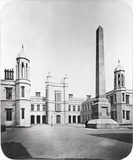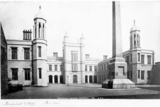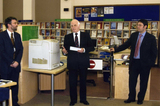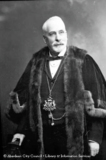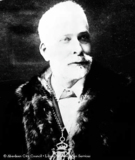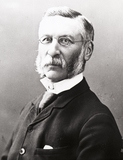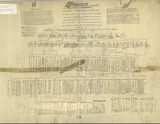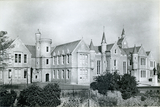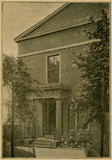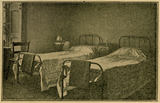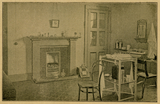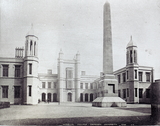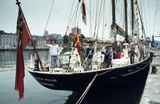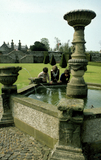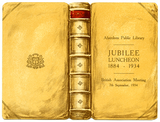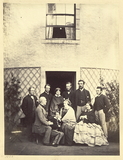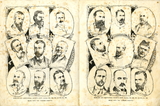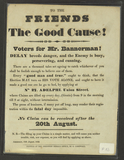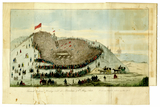|
Quick Search
|
Search Results
You searched for: More Like: 'Sir James McGrigor - an appreciation'
25 items
items as
Marischal College quadrangle
347 Marischal College quadrangle showing the buildings designed by Archibald Simpson and the Peterhead granite obelisk designed by James Giles and Alexander Ellis in 1860 to celebrate the life of Sir James McGrigor, graduate of Marischal College who later became Director General of the Army Medical Department. The obelisk was relocated to Duthie Park in 1906. The Quadrangle of Marischal College
513 The quadrangle of Marischal College, showing the obelisk in Peterhead Granite designed by Alexander Ellis and James Giles. The obelisk, sometimes known as the 'Sir James McGrigor Obelisk', was later removed in 1905 to a new site in the Duthie Park. Aberdeen Central Library, opening of Information Centre
1441 The refurbished Reference Library was opened as the "Information Centre" on 16 May 2006 by Sir James Milne, Chairman of the Balmoral Group. He is seen here with Neil Bruce (Service Manager, Culture and Sport, Aberdeen City Council) and Councillor John Stewart (extreme right). Provost James Walker
2022 A photographic portrait of Provost James Walker. He served as Provost of Aberdeen between 1903-1905. He entered the Town Council in 1870 and acted as their representative on the Endowments Board for many years. In 1907 Walker was presented with an oil portrait painted by Sir George Reid, R.S.A., in recognition of his extensive public service. Provost James Walker
2023 A photographic portrait of Provost James Walker. He served as Provost of Aberdeen between 1903-1905. He entered the Town Council in 1870 and acted as their representative on the Endowments Board for many years. In 1907 Walker was presented with an oil portrait painted by Sir George Reid, R.S.A., in recognition of his extensive public service. James Matthews of Springhill
2043 A portrait of Provost James Matthews (1819-1898). He served as Provost of Aberdeen from 1883-1886. He was the eldest son of Peter Matthews, teller at the Commercial Bank of Aberdeen, and Margaret Ross, who was the daughter of William Ross, architect and builder, who erected the Union Bridge. Matthews was apprenticed to Archibald Simpson and spent five years in the London office of Sir Gilbert Scott. On returning to Aberdeen he went into partnership with A. Marshall Mackenzie. He entered the Town Council in November 1863. Treasure 33: The Pedigree of the Cruickshanks of Stracathro
2321 Among the Local Studies collection of family trees is a chart from 1847 entitled Pedigree of the Cruickshanks of Stracathro. The title initially referred to the Cruickshanks of Langley Park but this has been scored out and replaced with Stracathro. A pedigree is a form of genealogical table. Collections of pedigrees were first made in the 15th century and, according to The Oxford Companion, were "a matter of aristocratic pride and of practical necessity for legal purposes". The term pedigree comes from the French 'pied de grue', meaning crane's foot, due to the resemblance of the genealogical lines to the thin legs and feet of the bird.
The pedigree of the Cruickshanks was compiled by E. G. G. Cruickshank, who features in the 10th generation detailed on the table.
The pedigree begins with the earliest ancestor at the top of the document with lines dropping down to succeeding generations. Each generation is given a Roman numeral and individuals within each generation are assigned Arabic numbers. The pedigree begins with "John Cruickshank first in Strathspey m. Mary Cumming of Elgin" and extends down to an incomplete 12th generation. The individuals in the 11th generation were mostly born in the 1870s.
The information listed on a family tree is dependent on the sources available and the purpose for which it was created. The information given on the Cruickshank's pedigree varies but typically includes an individual's date of birth, marriage details and date of death. Additional information is also supplied as is the case with the 7th generation of Cruickshanks - Margaret Helen is described as the daughter of Rev. Gerard of Aberdeen, author of a book whose title is unreadable, and sister to a Colonel Gerald. Details of army service are supplied for some individuals and many of the Cruickshanks were involved in the administration of India or served in the army there.
The tiny handwriting, use of abbreviations and sparse punctuation makes the document challenging to read so familiarity with the subject matter and names of places is useful. A later interpreter of the document has made a number of annotations in pencil. For example, one of the later additions points to an individual and reads "Is this W. Robertson of Auchinroath? Yes!"
In addition to a listing of descendants the pedigree is annotated with a number of original notes and a description of a coat of arms. The latin motto of Cavendo tutus translates as 'Safe through caution'. One note, quoting "an old paper", describes from where the family came prior to being in Strathspey. A note on the other side of the chart states that "distinguished Officer and Author the late Colonel Stewart of Garth" links the family to the Royal Family of Stewart and suggests the name of Cruickshank derives from "some deformity in the first cadet of the house."
Attached to the document is a letter dated 23 October 1927 from a Jim Bulloch to City Librarian G. M. Fraser. Bulloch explains that he got the pedigree from a Mr. Mackintosh of Elgin, thinks it is quite rare and that the library might like it for its collection. It has stayed in the Local Studies collection to this day.
The Gazetteer for Scotland website states that in 1775 Patrick Cruickshank, listed at No. 11 of the 7th generation, bought the estate of Stracathro in Angus. The property was subsequently inherited by his brother Alexander Cruickshank (1764 - 1846). Alexander hired the Aberdeen architect Archibald Simpson to build Stracathro House between 1824 and 1827. The Palladian Scottish country house still exists today.
University College London's Legacies of British Slave-ownership website indicates that Patrick and Alexander, and two other Cruickshank brothers, owned plantations on the Caribbean island of St Vincent that used slave labour. See Alexander Cruickshank's entry in the database here: 'Alexander Cruikshank of Stracathro', Legacies of British Slave-ownership database, http://wwwdepts-live.ucl.ac.uk/lbs/person/view/8590 [accessed 9th June 2020]. In 1833 when Britain abolished the ownership of slaves the government granted £20 million in compensation to former slave-owners. Alexander Cruickshank made three claims for compensation, two of which were successful.
In 1874, Stracathro House and estate were sold to Sir James Bannerman, Lord Provost of Glasgow, and father of Prime Minister Sir Henry Campbell-Bannerman. The country house was later used as a World War II hospital and owned by Tay Health Board before being sold to private owners in 2003. Aberdeen Grammar School
2383 The Grammar School premises shown in this image were opened in 1863. After 1882 they were added to at various times.
The bronze statue of Byron that stands outside the school, and is visible in this photo, was by Pittendrigh Macgillivray and was unveiled in 1923. The rector at the time of this photo, Sir James J. Robertson, was then the only headmaster of a Scottish school to be knighted while still in office. He received the honour in July 1956.
This image comes from the Lord Provost of Aberdeen, George Stephen's, Christmas card of 1956. Aberdeen Eye Institution
2424 The doric portico and entrance to 142 King Street during its time as the Aberdeen Eye Institution. Previously known as the Aberdeen Ophthalmic Institution, this specialist eye hospital was founded in 1835 by Sir James McGrigor and Dr. John Cadenhead. It was originally located on the south end of Belmont Street and moved to 142 King Street in 1903.
142 King Street was built by the architect John Smith as his family home and office in around 1817. The expansion of King Street and nearby streets surrounded the villa with access from King Street was through a small pend. After the Aberdeen Eye Institution the building was occupied by the Boilermakers Social Club into the early 2000s.
This image comes from an Annual Report & Abstract of Accounts for the hospital from the 1911. Aberdeen Local Studies hold a number of these reports from the period 1896 to 1913. Aberdeen Eye Institution
2425 A small ward in 142 King Street during its time as the Aberdeen Eye Institution. Previously known as the Aberdeen Ophthalmic Institution, this specialist eye hospital was founded in 1835 by Sir James McGrigor and Dr. John Cadenhead. It was originally located on the south end of Belmont Street and moved to 142 King Street in 1903.
142 King Street was built by the architect John Smith as his family home and office in around 1817. The expansion of King Street and nearby streets surrounded the villa with access from King Street was through a small pend. After the Aberdeen Eye Institution the building was occupied by the Boilermakers Social Club into the early 2000s.
This image comes from an Annual Report & Abstract of Accounts for the hospital from the 1911. Aberdeen Local Studies hold a number of these reports from the period 1896 to 1913. Aberdeen Eye Institution
2426 The interior of 142 King Street during its time as the Aberdeen Eye Institution. Previously known as the Aberdeen Ophthalmic Institution, this specialist eye hospital was founded in 1835 by Sir James McGrigor and Dr. John Cadenhead. It was originally located on the south end of Belmont Street and moved to 142 King Street in 1903.
142 King Street was built by the architect John Smith as his family home and office in around 1817. The expansion of King Street and nearby streets surrounded the villa with access from King Street was through a small pend. After the Aberdeen Eye Institution the building was occupied by the Boilermakers Social Club into the early 2000s.
This image comes from an Annual Report & Abstract of Accounts for the hospital from the 1911. Aberdeen Local Studies hold a number of these reports from the period 1896 to 1913. Albyn Terrace
2604 Built in the late 1860's, this row of 16 terraced houses may have been designed by the architect J. Russell Mackenzie. It was laid out at the west end of Albyn Place on the lands of Rubislaw owned by the Skene Family.
James Skene was a friend of Sir Walter Scott, and lived in Albyn Place in Edinburgh, and it is believed that some street names in this area derive from that association eg: Albyn, Waverley.
This photograph, by George Washington Wilson in around 1880, shows the two stories, plus garrets, built of rock faced granite.
Both end elevations are gabled and have oriel windows, rounded towers and conical roofs. They had between 14 and 18 rooms and were then occupied by merchants and advocates. Most have now been converted to office use. Malcolm Miller
3813 This photograph shows the ship the Malcolm Miller docked in Aberdeen Harbour with a crew onboard.
The boat is moored at Jamieson's Quay in the Upper Dock. The Harbour Office on Regent's Quay and the tower of the Citadel at Castlegate can be seen in the background.
The Malcolm Miller was a schooner built by John Lewis & Sons Ltd. for the Sail Training Association. It was a 300-ton vessel with a sail area of over 7000 square foot and had engine propulsion for use in narrow waters.
The ship's launch on 5th October 1967 was reported in the Evening Express newspaper of that day. The Malcolm Miller was officially launched by Lady Miller, and it was named after the late son of Sir James, former provost of Edinburgh, and Lady Miller.
During its time as a Sail Training Association vessel the Malcolm Miller provided nautical experiences to many youngsters. It had a sister ship called the Sir Winston Churchill.
The vessel has an entry on the Aberdeen Built Ships website that details its later history.
This image comes from a collection of slides donated to Aberdeen City Libraries by Aberdeen City Council's publicity department. Pitmedden Garden
4207 A photograph showing three boys admiring the fountain at Pitmedden Garden.
Pitmedden Garden is a Natural Trust for Scotland property. Their website describes it as a "re-created Scottish Renaissance walled garden with vibrant floral designs and Museum of Farming Life."
Concerning its history, the website states "the Great Garden dates back to 1675 when it was originally laid out by Sir Alexander Seton." [...] "In the 1950s Pitmedden was gifted to the Trust who re-created the garden based on 17th-century plans after it was ploughed up to grow vegetables during the Second World War and used as a kitchen garden for over 100 years."
This fountain is detailed in an entry on Historic Environment Scotland's CANMORE website (CANMORE ID: 338622). Quoting a guide pamphlet by Dr James Richardson, designer of the garden restoration, it states "In the re-creation of the Great Garden of Pitmedden, the National Trust for Scotland not only has established once again the site of the original fountain but it has erected a further fountain as a focal point in the centre of the Great garden. The sculptured stones that compose this second fountain have an interesting history as seven of them formed, at one time, part of the Cross Fountain of Linlithgow designed and executed by Robert Milne, King's Master Mason, to commemorate King Charles II's Restoration. These detached fragments were given by the Ministry of Works. Three fragments of the original Pitmedden construction have also been worked into the composition of the fountain."
Looking west, a stairway up to Pitmedden's terrace garden and Pitmedden House can be seen in the background.
This image likely dates from the 1970s. It comes from a collection of slides donated to Aberdeen City Libraries by Aberdeen City Council's publicity department. Treasure 45: British Association for the Advancement of Science - 1934 Visit Souvenir
214 The British Science Association holds its annual British Science Week in March when a variety of events including talks and activity days for adults, schools, and families are held country-wide to celebrate science and technology.
The British Science Association has evolved from the organisation which was founded in 1831 as the British Association for the Advancement of Science with the aim of promoting interest and research in the sciences, believed to be in decline at the time.
Their annual meetings, held in different cities across the UK during a week in early September, allowed professional scientists to discuss their current research not only with members of other scientific disciplines but also with the general public.
In this Year of Innovation, Architecture and Design, it may be interesting to look back at these annual meetings of the Association when Aberdeen welcomed 2000 - 3000 scientists and members in 1859, 1885, 1934 and 1963.
The 1934 visit was even more special because it coincided with the Jubilee of the city's adoption of the Public Library Acts in 1884. A special luncheon was held on Friday 7 September in the Aberdeen Central Library Reference Department when the City Librarian, G.M. Fraser, and the Library Committee entertained 112 invited guests, including the President Sir James H. Jeans, the President-elect Professor W. W. Watts, and about 70 of the more distinguished members of the Association, with representatives of educational, official, professional, commercial and industrial interests of the city. This was believed to be the first time that such an event had been held in a public library and it was regarded as hugely successful.
This attractive menu card in the form of the binding of a book was created by local printing firm Taylor and Henderson at a cost of £9. 5s. 6d. for 120 copies. Catering, including the food, decorations and staff, was provided by the Royal Athenaeum Restaurant at a cost of 5 shillings per head - a total cost of £50 11s. 3d
Having been greeted in the Library Committee Room by Lord Provost of Aberdeen Henry Alexander, the guests were guided by members of staff through the Lending Department to the main staircase which was laid with crimson cloth and decorated with plants and shrubs.
The Library staff were also able to enjoy the day by being treated to lunch at the nearby Caledonian Hotel on Union Terrace, although they were expected to return in time to help escort their honoured guests from the Library.
Guests included Sir Arthur Hill of Royal Botanic Gardens, Miss Olga Nethersole, founder of The People's League of Health, Dr Marie Stopes, paleobotanist, but perhaps better remembered for her work on women's rights and birth control, Sir Josiah Stamp of London Midland and Scottish Railway, and Sir Arthur Eddington, astronomer.
Treasure 95: Todd Family Album, 1858-1865
314 This treasure is a family photograph album of the Todd family covering the years 1858 to 1865. The photographs were taken by James Joseph Todd (1834-1904) and the album was donated to the library by Lorna L. Todd, née Lawrence, (1886-1971).
Lorna was the wife of Reginald Todd (1868-1948), the second child of James Joseph Todd and Ann Hogarth (1845-1882).
During the years covered in the album the Todd family lived at Maryculter House on the banks of the River Dee. The head of the family was Thomas Todd (1803-1868). He came to Aberdeen in 1849 and became one of the principal partners in the firm of Alexander Hadden & Sons, manufacturers in the Green, with his brother in law James F. Hadden.
Thomas was born in London in 1803. His father, Joseph Todd Snr., began his working life as a haberdasher and silk mercer and steadily became one of the wealthiest men in the country.
The Todd family owned Twickenham Park estate and had architect L. W. Lloyd design a large mansion there by the side of the River Thames that was completed in 1828.
The album documents not just the Todd family, and connected families like the Haddens and Hogarths, but also includes other prominent Aberdonians such as Sir Andrew Leith Hay and Hugh Leslie of Powis. They appear to have been photographed during visits to Maryculter House.
View our Treasures exhibition on the interactive screen to find out more about this early example of portrait photography The Highland and Agricultural Society's Show
405 The inside 2 pages of a 4-page Evening Gazette supplement about the large Highland and Agricultural Society Show that took place in Aberdeen on 24th, 25th, 26th and 27th July 1894.
These pages show illustrated portraits of various prominent individuals involved in the Society and the show:
A. M. Gordon of Newton
Walter George Hepburne-Scott (9th Lord Polwarth)
F. H. Forbes of Irvine of Drum
Arthur James Balfour (then an M.P., later to be Prime Minister between 1902 and 1905)
George V (then the Duke of York)
Charles Henry Gordon-Lennox (6th Duke of Richmond, 6th Duke of Lennox, and 1st Duke of Gordon)
Dr Alexander Profeit (Royal doctor at Balmoral from 1874)
James Macdonald (Secretary of the Highland and Agricultural Society from 1893 to 1912)
Baillie Daniel Mearns (later Provost of Aberdeen from 1895-1898)
J. Campbell of Old Cullen
George Bruce (Secretary of the Royal Northern Agricultural Society)
J. Sleigh of Strichen
W. H. Lumsden of Balmedie
Sir George Macpherson-Grant
Colonel Smith of Midmore
J. Marr of Cairnbrogie
Sir Arthur Henry Grant (9th Baronet of Monymusk)
P. M. Turnbull of Smithston Voters for Mr. Bannerman!
486 A broadside from 10th August 1832 inviting the eligible of Aberdeen to register as electors and to support Mr. Bannerman.
Alexander M. Munro in Memorials of the Aldermen, Provosts, and Lord Provosts of Aberdeen (1897) states that Sir Alex Bannerman of Elsick (1788-1864) won the elections in December 1832 after his opponent James Hadden retired from the contest.
Bannerman became the first M.P. for Aberdeen after the Reform Bill enactment passed in July 1832. This allowed the city to elect its own representative in the Parliament instead of voting for a member as part of a larger group of burghs.
The Aberdeen Journal explained that this act also prescribed that all eligible electors would receive a printed blank claim or schedule when applying for voting, as this historical document also states.
This broadside, printed at the Aberdeen Herald Office by G. Cornwall, indicates that the registration office was located at 27 Adelphi. Grand reform meeting held at Aberdeen, 18th May 1832
530 A colourised lithographed sketch of the Grand Reform Meeting that took place on Broad Hill, Aberdeen on Friday 18th May 1832.
Popular and parliamentary support for electoral reform had been growing across the United Kingdom in this period. At the time, only a small number of wealthy landowners had the right to vote, the franchise was geographically inconsistent, and the representation by members of parliament was out-dated.
This Aberdeen meeting, like many that took place around the country at the time, was organised following the House of Lords blocking the Third Reform Bill of Prime Minister Charles Grey (1764-1845), 2nd Earl Grey, and the subsequent resignation of Grey and his Whig ministers.
Newspaper accounts of the meeting indicate that attendees had just learnt that the Duke of Wellington (1769-1852), a Tory opponent to reform, had been unable to form a government following the resignation of the Whigs and an invitation from King William IV, and that the monarch had recalled Earl Grey.
Organised by prominent local supporters of electoral reform, the Reform Committee, the meeting agreed seven resolutions for presentation to parliament including the following: consternation at the bill not being passed, support of Earl Grey and colleagues, agreement to withholding national supplies (funding) from the government until the bill is passed, and that Joseph Hume (1777-1855), then MP for Middlesex, present the petition instead of the member for the Aberdeen boroughs, Horatio Ross (1801-1886), who was accused of backsliding on reform.
The report in the following day's Aberdeen Chronicle newspaper suggest the meeting was attended by 30,000 to 40,000 people. The Tory-leaning Aberdeen Journal, in its issue of Wednesday 23rd May 1832, page 2, gives an estimate of 15,000 to 20,000.
Contingents of various trades began to muster at Union Street West at about 1.30pm. A large procession proceeded east along the street and were joined by the Reform Committee from the Royal Hotel, 63 Union Street, located just after the junction with Market Street.
The full procession, with the Committee at its head and joined by deputations from the country, travelled to the Links via Castle Street, King Street, Frederick Street and Constitution Street. Several bands accompanied the procession and there were a large number of banners with reform slogans.
On the motion of Reverend William Jack (1768-1854), principal of King's College, Sir Michael Bruce of Stenhouse and Scotstown (1798-1862) was called to chair the meeting. John Angus (1799-1878), an advocate and later Town Clerk of Aberdeen, was the secretary.
Speakers included General Andrew Leith Hay of Rannes (1785-1862), Alexander Bannerman (1788-1864), Sir John Forbes of Craigievar (1785-1846), Alexander Blackie, banker, Thomas Burnett, younger of Leys (1778-1849), John M. Gerrard of Midstrath, Alexander Kilgore, surgeon, James Forbes of Echt, Alexander Stronach of Drumallan, James Nicol, advocate, William Allardyce, wine merchant, Harry Leith Lumsden of Auchindour, William Moir of Park and Alexander Forbes of Ainslie.
Both the account in the Aberdeen Chronicle and the speeches on the day remark on the disruptive potential of the crowd, under circumstances of reform not being progressed. Though the speakers urged those in attendance to continue in a peaceful manner.
Some speakers compared the fight for electoral reform to that for religious freedom in Scotland. There is explicit and repeated support given for William VI, but the Duke of Wellington is considered an inappropriate progressor of reform. The return of Earl Grey is promoted.
Faced with the prospect of William VI ennobling new Whig members of the House of Lords, Tory opponents of the Third Reform Bill abstained from votes and it passed through the upper house. The Representation of the People Act 1832 was given royal assent on 7th June 1832, and its Scottish equivalent around the same time, and came into law.
The Act was a substantial reform of Britain's antiquated electoral system, redistributing seats and changing the conditions of the franchise, but still left most people without the vote. Subsequent popular and parliamentary politics would led to further legislation and the fuller suffrage of modern times.
Document dimensions: 26 x 40 cm. |



